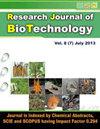替莫唑胺联合用药对胶质母细胞瘤患者的安全性和疗效;Meta 分析
IF 0.2
Q4 BIOTECHNOLOGY & APPLIED MICROBIOLOGY
引用次数: 0
摘要
在全球范围内,胶质母细胞瘤是发病率最高的胎儿脑肿瘤。得到临床诊断的胶质母细胞瘤患者需要接受综合治疗,这种治疗将放疗和化疗药物结合在一起,并显示出良好的疗效。治疗胶质母细胞瘤的首选药物是替莫唑胺,无论是单独使用还是联合使用。研究表明,替莫唑胺与其他药物和放疗相结合治疗胶质母细胞瘤,能有效缩小肿瘤体积、预防复发和限制肿瘤进展。研究还强调了替莫唑胺联合用药的安全性,以及肿瘤、大小、生长和复发的病理生理学。为了进行荟萃分析,我们利用迄今为止发表的与替莫唑胺联合用药治疗胶质母细胞瘤最相关的科学研究,对科学文献进行了详细的检索。检索涉及多个数据库,包括 Scielo、Cochrane Central Register of Controlled Trials 和 PubMed。使用 MedCalC 工具按照 Prisma 标准对研究之间的几率比、风险因素分析和相对风险进行了荟萃分析。本次分析共使用 Cochrane 对照试验中央登记册、Scielo 和其他数据库检索了 1635 项研究。荟萃分析的三个不同参数几率比、风险差异和相对风险均具有显著性,P值小于0.001(TMZ与其他化疗药物的比较)和P值小于0.003(TMZ与放射治疗的比较)。TMZ联合其他化疗药物的几率比(2.539~3.466)、风险差(1.345~1.669)和相对风险(0.192~0.280)的95% Cl值均高于TMZ联合放疗(几率比1.051~1.327;风险差0.0116~0.0623;相对风险1.016~1.100)。在治疗 GBM 时,发现 TMZ 与其他化疗药物联合使用比单独使用 TMZ 更为成功。基于 TMZ 的临床试验为新确诊的实体瘤 GBM 患者提供了更高的生存率。本文章由计算机程序翻译,如有差异,请以英文原文为准。
Safety and Efficacy of Temozolomide Combinations in Glioblastoma Patients; A Meta-Analysis
Globally, glioblastoma is the fetal brain tumor with the highest incidence. Patients with glioblastoma who have received a clinical diagnosis need combination therapy, which combines radiation and chemotherapy drugs that have shown promising benefits. The treatment of choice for glioblastoma, both alone and in combination, is temozolomide. Studies have shown that temozolomide combined with other medications and radiotherapy in the management of glioblastoma is effective in reducing tumor size, preventing recurrence and limiting tumor progression. The study also emphasizes the safety profile of temozolomide combinations and pathophysiology of tumor, size, growth and reoccurrence. For the meta-analysis, a detailed search of scientific literature was conducted utilizing the most relevant scientific studies published to date on the intervention of temozolomide combinations to manage Glioblastoma. A search was conducted across a number of databases including Scielo, Cochrane Central Register of Controlled Trials and PubMed. The MedCalC tool was used to do a meta-analysis in accordance with Prisma standards for odds ratio between studies, risk factor analysis and relative risk. The Cochrane Central Register of Controlled Trials, Scielo and other databases were used to retrieve a total of 1635 studies for the current analysis. The meta-analysis with three distinct parameters odds ratio, risk difference and relative risk was significant with p value <0.001 (for TMZ with other chemotherapeutic agents) and p value <0.003 (for TMZ with radiation therapy). The 95% Cl for TMZ with other chemotherapeutic agents was higher for odds ratio (2.539 to 3.466), risk difference (1.345 to 1.669) and relative risk (0.192 to 0.280) over TMZ with radiation therapy (Odds ratio 1.051 to 1.327; Risk difference 0.0116 to 0.0623 and Relative risk 1.016 to 1.100). When treating GBM, TMZ in combination with other chemotherapeutic drugs has been found to be more successful than TMZ alone. Clinical trials based on TMZ offer GBM patients with freshly diagnosed solid tumors a better survival rate.
求助全文
通过发布文献求助,成功后即可免费获取论文全文。
去求助
来源期刊

Research Journal of Biotechnology
BIOTECHNOLOGY & APPLIED MICROBIOLOGY-
CiteScore
0.60
自引率
0.00%
发文量
192
期刊介绍:
We invite you to contribute Research Papers / Short Communications / Review Papers:
-In any field of Biotechnology, Biochemistry, Microbiology and Industrial Microbiology, Soil Technology, Agriculture Biotechnology.
-in any field related to Food Biotechnology, Nutrition Biotechnology, Genetic Engineering and Commercial Biotechnology.
-in any field of Biotechnology related to Drugs and Pharmaceutical products for human beings, animals and plants.
-in any field related to Environmental Biotechnolgy, Waste Treatment of Liquids, Soilds and Gases; Sustainability.
-in inter-realted field of Chemical Sciences, Biological Sciences, Environmental Sciences and Life Sciences.
-in any field related to Biotechnological Engineering, Industrial Biotechnology and Instrumentation.
-in any field related to Nano-technology.
-in any field related to Plant Biotechnology.
 求助内容:
求助内容: 应助结果提醒方式:
应助结果提醒方式:


